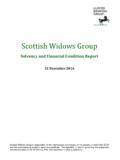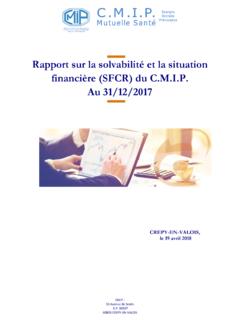Transcription of SOLVENCY FINANCIAL CONDITION REPORT (SFCR) …
1 SOLVENCY FINANCIAL CONDITION REPORT (SFCR) Version 2017 Table of content 1. Management structure, remuneration and Membership .. 3 Management structure ..3 Remuneration .. 14 Membership .. 15 2. Fit & Proper, external functions and transactions with Governing Bodies .. 18 Fit & Proper .. 18 Loans, credits or guarantees and insurance contracts for Governing Bodies .. 19 3. Risk Management System, ORSA process and risk management function .. 20 Risk Management System .. 20 ORSA process .. 21 Risk Management Function .. 25 4. Organizational structure, internal control, compliance function, integrity and IT infrastructure .. 26 internal Control System .. 26 Compliance Function .. 28 5. Internal Audit Function .. 31 6. Actuarial function.
2 34 7. Outsourcing .. 36 8. Other relevant governance domains: Swiss Branch .. 37 9. Status of the governance memorandum and date .. 39 1. Management structure, remuneration and Membership Management structure a) Board of Directors (composition, duties, operation) Competences The Board of Directors outlines the general policy of the Association which is subject to prior agreement of the General Meeting. The Board of Directors ensures the monitoring of the business of the Association and of its management by the Executive Committee, which is appointed by the Board from among its Members. The Board of Directors has a broad mandate to investigate in this respect. To protect the interest of the Association, every Director is requested to sign a confidentiality agreement.
3 The Chairman of the Board supervises the division of the powers / competencies between the Board of Directors and the Executive Committee. The President of the Executive Committee is appointed by the Board of Directors in accordance with the NBB. The Board of Directors, after consulting the NBB, shall confer to the Executive Committee the competence to take any decisions relating to the administration and the objects of the Association and to represent the Association, with regard to this management, in relations with members of staff, Members of the Association and any third parties, according to the laws and regulations in force and to the Articles of Association. Composition The NBB must be informed prior to as well the appointment or reappointment as the resignation of persons participating at the effective management.
4 The (re)nomination of members of the Board of Directors is subject to prior written approval by the Belgian supervisor who assesses the candidates in accordance with the principles included in the circular on Fit & Proper requirements and integrated in the Fit & Proper policy. The Board is responsible to install an appropriate recruitment-, evaluation- and education policy and will therefore perform an assessment of the candidate on fit- and properness at the moment of selection. The NBB will receive a copy of the fit and proper assessment. The Board of Directors is appointed for a three-year period by the Annual General Meeting, who can dismiss them at any time, and is composed of at least 9 Directors. A minimum of two Members of the Board are independent and the majority of Board members are non-executive Directors.
5 The composition of the Board is balanced considering the respective skills, experience and background of each of the Board members. Board members undertake that they have sufficient time to exercise their duties, taking into consideration the number and importance of their other commitments. From among its Members who are not Members of the Executive Committee, the Board of Directors elects a Chairman and two vice-Chairmen for a period of three years. They are eligible for re-election. In the absence of the Chairman, the Board of Directors meets under the presidency of a Vice-Chairman or in his absence, of a Director chosen by the Directors, who is not a member of the Executive Committee. On completion of their three-year period of office, Directors are eligible for re-appointment.
6 If there is a vacancy for one or more Directors, the remaining directors have the right to arrange for temporary replacements until the next General Meeting. The Board of Directors may call upon the services of any person whose presence is considered to be useful. Such person shall have no vote in the proceedings. In line with the fit and proper requirements applicable by the fit and proper policy, the Board of Directors performs annually a self-assessment. Incompatibilities Members of the Board of Directors who are not Members of the Executive Committee may not engage in any management function of the Association. Meeting dates and location The Board of Directors meets, under the presidency of the Chairman, as often as the interests of the Association require, and whenever five or more Directors make a written request for such a meeting.
7 Convocation Notice of Board meetings are sent by ordinary mail, by e-mail or by fax message at least ten days before the date of the meeting. This notice states the date, place, time of the meeting and the items on the agenda. The Board of Directors can only take decisions if all the Directors have been given notice of the meeting. Proceedings of the sitting Each Director has one vote. The Board of Directors can only take decisions if a majority of Directors are present or represented. Any Director may, by letter, by e-mail or fax, give authority to another Director, to represent him at a particular meeting of the Board of Directors and to vote in his name. No Director may exercise more than two such proxy representations. In the case of a tied vote, the Chairman of the meeting has the casting vote.
8 All decisions of the Board of Directors are taken by simple majority of expressed votes, with the exception of: A three-quarters majority of expressed votes is required to: cases stated in article 27 3, 7 and 28 1 of the Articles of Association, the acceptance of a new Member, the expulsion of a Member, the cessation of the issuing of insurance policies or the decision to dissolve the Association. Reporting Minutes are kept of every meeting. They are signed by the Chairman after approval. Copies and extracts of minutes are signed by the Chairman or a member of the Executive Committee. Remuneration Directors of the Mutual are not remunerated with the exception of the Independent Directors who receive an attendance fee. Board members, travelling on ELINI business will be reimbursed for travel expenses according the Board expense policy.
9 Conflict of interests All members of the Board shall withhold from participating in discussions and decisions whereby they have a personal or business interest for their company, which is not compatible with the interests of ELINI or where the decisions within ELINI concerns the individual ELINI Member to which the Board member relates as an employee. These members shall in each case where they feel confronted with such a conflict of interests, inform the Chairman of the meeting where such point is on the agenda, so that in due time can be decided how to deal with the further discussion and decision process. b) Executive Committee (composition, functions, operation) Competences The Executive Committee has full authority to undertake the daily management of the Association.
10 The Executive Committee may in particular classify risks, amend such classifications, accept or refuse in whole or in part the risk proposed, determine the forms, the general and specific conditions of insurance policies, sign any co-insurance or reinsurance agreements, establish general administration costs, receive any income and fund sums, decide on the use of funds, make any payments with or without subrogation, accept any real or personal guarantees or dispense therewith, grant release of prior rights registered or mortgage rights as well as any notices of default, register attachments or other property rights and further impediments, with or without proof of payment, require conversion of registered public loan bonds into bearer bonds, prepare a list of guarantee fund investments, appoint and dismiss any Members of staff of the Association, determine their salaries, functions and, where applicable, establish any internal standing orders, negotiate, arrange composition, acquiesces, waive rights, compromise or reach a settlement with respect to any interests of the Association.





